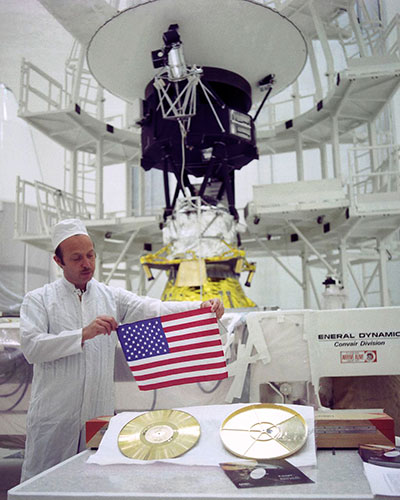John Richard Casani, 1932-2025John Casani, a fixture for decades at NASA’s Jet Propulsion Laboratory, died on June 19, 2025 as a result of a heart attack. He was 92. Throughout his multi-faceted JPL career, Casani is perhaps best remembered for managing all of the "flagship" outer-planet missions during critical phases of their development. He set standards as a leader who maintained an open-door policy, who repeatedly faced down Congress on matters of funding, and who did right by the many loyal people working underneath him.
Born to Jack and Julia Casani on September 17, 1932, John grew up in the suburbs of Philadelphia, Pennsylvania. He attended Norwood Academy in Chestnut Hill, and at a young age discovered the thrills of mechanization. He endeavored to enhance the lives of his parents by creating automated equipment for the house – including a home-made garage door opener, plus devices to automatically switch room lights on and off. John swam on his high school team as well as for the University of Pennsylvania, where he attended college and was a member of the Phi Kappa Psi fraternity. His degree was in electrical engineering.
After graduating Penn in 1955, Casani worked briefly at the Rome Air Development Center in New York before abruptly quitting to move to California with a fraternity brother. He then proceeded to interview at various Los Angeles aerospace firms including North American Aviation and the Jet Propulsion Laboratory. In 1956, Casani accepted a technician position at JPL, worked briefly on military missile programs, but then refocused on spacecraft as part of a greater JPL transition to lunar and planetary missions. John Casani lent his engineering efforts to the early Pioneer, Explorer, and Mariner programs, gradually rising through the Lab's ranks into management.

Above: Standing in front of the Voyager 2 spacecraft on August 4th, 1977, John Casani holds an American flag which will be placed aboard the ship. Below this flag sits a "Golden Record" containing images and sounds of Earth which will also be placed aboard as a greeting to extraterrestrials. (NASA-JPL/Caltech)
As project manager, he escorted both Voyager spacecraft through their critical pre-launch and post-launch phases. The famous "Voyager Golden Records," containing messages for alien civilizations who might one day recover these spacecraft, resulted from a request Casani made to astronomer Carl Sagan to include some form of extraterrestrial greeting aboard the ships. Later, Casani ran the Galileo mission to Jupiter for over ten years throughout its inception and development, then became an assistant JPL director overseeing all flight projects.
Eventually Casani returned to project management, heading the Cassini/Huygens mission to Saturn after its own development started to be perceived as troubled due to funding and other high-level issues. During the overall course of his time as a project manager, Casani acquired a reputation for being "a man with no corners," as one colleague termed it, due to Casani's ability to escape technical or logistical dead ends which might have seemed insurmountable to others. Occasionally, when NASA Headquarters assumed that an issue might be unfixable, Casani would tell them, "Well, we haven't concluded that there isn't a solution," and lead his team to successfully identifying one. In later years, Casani became Chief JPL Engineer – a position created specifically for him, reporting straight to the JPL Director on core engineering standards and practices.
Repeatedly, John Casani attempted retirement. Each time, though, he returned via invitation to the JPL campus – be it to join a technical review panel (for the Shuttle Radar Topography Mission) or to assist with a failure analysis (Mars Climate Orbiter, Mars Polar Lander). Casani once explained his motivations and work ethic like this: "The thing that I get the biggest charge out of, you know, is just… making things happen. You know, setting out for whatever you're doing, and finishing it. I get a great deal of satisfaction out of that."
One of Casani's final efforts at JPL involved documenting his operational philosophies and strategies for two reference manuals called Design Principles and Flight Project Practices which are still in use. He received multiple awards over the course of his career, including the NASA Distinguished Service Medal, the NASA Exceptional Achievement Medal, and the NASA Outstanding Leadership Medal. In 1992, the University of Pennsylvania awarded him an honorary doctorate. And in 2009, the Smithsonian Air and Space Museum awarded Casani its Michael Collins Trophy for his distinguished career in aerospace.
John was preceded in death by his wife, Lynn (Seitz) Casani (d. 2008). The couple had five sons.












